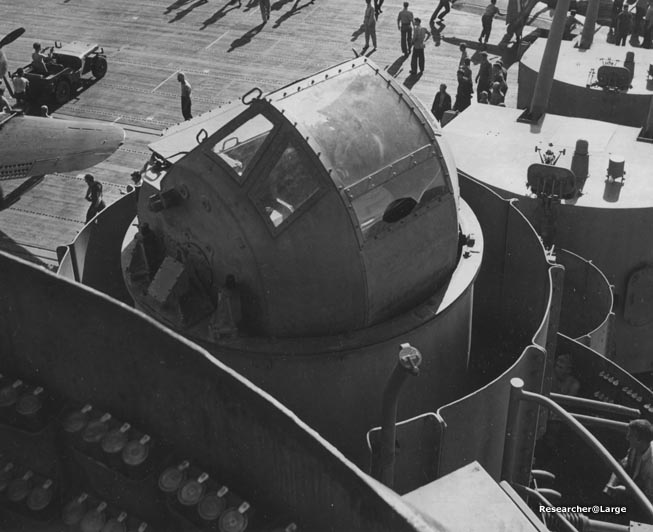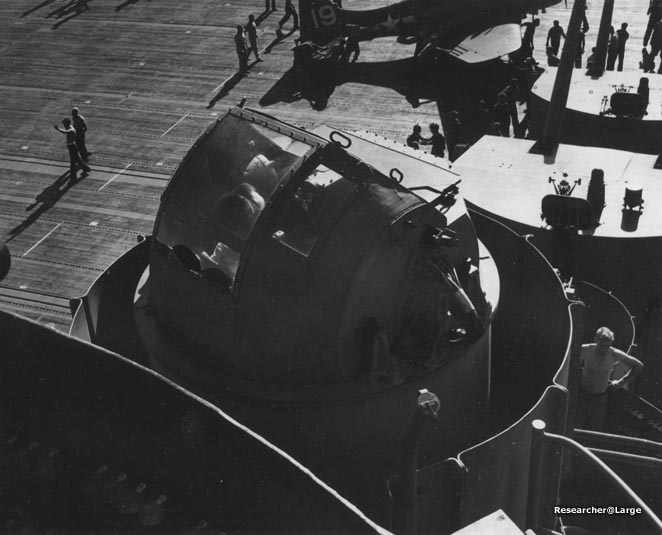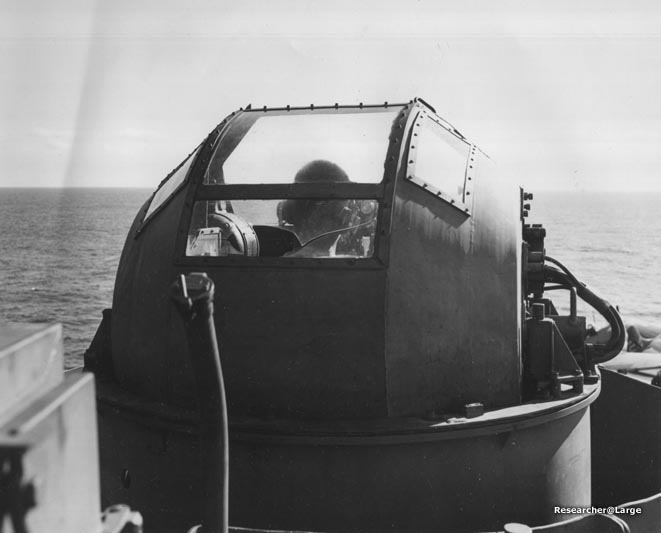


If you can see this text here you should update to a newer web browser
Normal | Highlight & Comment Highlighted Text will be in Yellow
|
FILE NO. U.S.S. ESSEX C-O-N-F-I-D-E-N-T-I-A-L
1. This ship has been under attack recently by enemy planes of dive bombing and torpedo bombing types. This was the first battle test for the ship's automatic weapons controlled by the subject director. The events of this attack and the operational experience obtained since the last report from (SIC) the basis for the comments below. 2. The director has proved trustworthy and reliable in battle and in war cruising. Operators express confidence in its ability to maintain its performance with the following exceptions: (a) slewing in elevation and train simultaneously places a strain on the power motor causing it to slow down noticably. This causes erratic operation and may cause this cital part to fail at a crucial moment. This same condition was encountered in cold weather when the lubricant was stiff as mentioned in a previous report. A large capacity power motor is recommended to insure reliability under all conditions of operation. Besides the severe strain slew control puts on the power motor as mentioned above, when the director is sloewed in both elevation and train, the precessive force applied to the gyro causes it to hunt between the elevation and train contacts so that the director is actually slewing in only elevation or train at any one instant. The reason this occurs is because the necessary fineness of slew adjustment, number A-29VT, A31DT cannot be obtained under operation conditions. This has several additional effects on the operation: FIrst, the erratic gyro performance requires several seconds to return to normal so that tracking rates can be used; Second, the alteration of the elevation and train rates at different loads, (1) |
||||||||||||||||||||||||||||||
|
FILE NO. U.S.S. ESSEX C-O-N-F-I-D-E-N-T-I-A-L
2. (a) (Cont'd). train being the greater load, causes the main drive belt to slip; this in turn causes the director to operate jerkily. (b) When the range is shifted rapidly to the maximum or minimum values the inertia set-up in range cam is sufficient to drive the cam bearing into the limits of the cam groove. This force is absorbed by the bearing and differential D-2, Ordnance drawing #223100, putting a severe strain on these units. Differential D-2 has been slightly bent in one case. This condition may cause the bearing to fail or the differential to bend to such an extent that the director would be put out of commission. (c) The director has been easy to maintain with the exception that access to the computing section is difficult. This could be corrected by installing a cover plate on the front of this section. Also there is no access to the train rack without lifting the director which would be very difficult at sea. Access is necessary for inspection of the rack for rust, excess wear, and condition of the lubricant. (d) In several instances bearing rates greater than the present train rate of the director have been encountered, even with the range at the minimum setting. In an effort to keep on the target the director has slipped into slow control. When this happened the target was lost completely and had to be relocated in the sight. The "Betty" type torpedo bomber is a particular target where this occured. The operator could not keep the director on in train smoothly. (The Betty passed up the starboard side at point blank range) (e) An increase in the field of vision to the front and side of the line of sight of the director operator is important. In battle it was found that the operator had difficulty shifting targets to either side even when they were separated by only a few hundred yards. The ability to rapidly shift targets is of prime military importance and the director construction should be altered to correct this defect. This vessel has installed plasti-glass windows in the top and side of the two directors installed. This has greatly improved this defect. However, when the director is elevated the operator can not see below the edge of the top of the computing section, which makes it very difficult (2) |
|||
|
FILE NO. U.S.S. ESSEX C-O-N-F-I-D-E-N-T-I-A-L
2. (e) (Cont'd). to shift from a target at a high angle elevation to one at a low angle of elevation. The plasti-glass windows installed on the Mk.49 Directors of this ship are shown in the photographs of Enclosure (A).3. There has been no instance of moisture entering any part of the director. 4. The director requires more training and experience than the Mark 51 director but this is more than compensated for by the supior performance of the Mark 49. It is felt that one of the contributing factors to this better performance is the fact that the operator of the Mark 49 director does not have to shift his weight while tracking. When the operaor of the Mark 51 director his feet to follow a target the shift of his weight causes the reticule to leave the target giving erratic performance. Also the fact that the Mark 49 director operator is protected from the flash and blast of nearby guns and from the wind contributes to its better performance. It is significant to note that gun mounts controlled by the Mark 49 director are credited with having shot down one out of two planes fired on in one case and one out of three in the other. Mounts controlled by Mark 51 directors claim hits but no "sure kills". Operators feel that these performances could be improved, however, with a continuous true range input such as radar would provide. The directors on this ship are not fitted with radar at the present time. Operators prefer to use the reticule rather than the telescopic sight. This is because the telescope is difficult to use at high angles of elevation since the eye must be held up to the eye piece. The reticule also allows a large field of vision. 5. In considering the overall results from the Mk.49 and Mk.51 Directors for the 40 MM Mounts, the Mk.49 DIrectors on this ship far excell the Mk.51 Director. Therefore, it is requested that authority be granted to install Mk. 49 Directors (reconditioned), which have been removed from destroyers at Navy Yard, Pearl Harbor, during the first availability for 40MM Mounts (3) |
|||
|
FILE NO. U.S.S. ESSEX C-O-N-F-I-D-E-N-T-I-A-L
5. (Cont'd). #1, 4, 6, and 7. Necessary wiring has been run between these mounts and their director platforms.
R.A. OFSTIE.
c.c:
|
|||
|
|
SOURCE:
Transcribed by RESEARCHER @ LARGE. Formatting & Comments Copyright R@L.